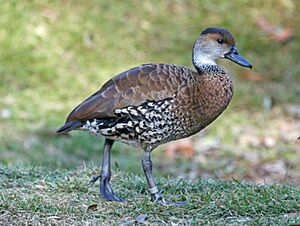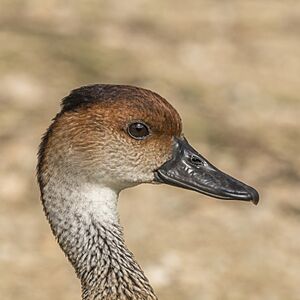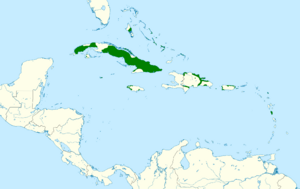West Indian whistling duck facts for kids
Quick facts for kids West Indian whistling duck |
|
|---|---|
 |
|
 |
|
| Conservation status | |
| Scientific classification | |
| Genus: |
Dendrocygna
|
| Species: |
arborea
|
 |
|
| Synonyms | |
|
Anas arborea Linnaeus, 1758 |
|
The West Indian whistling duck (Dendrocygna arborea) is a special type of whistling duck. It makes its home and raises its young in the beautiful Caribbean islands. You might also hear it called the black-billed whistling duck or the Cuban whistling duck.
Contents
Where the West Indian Whistling Duck Lives
This duck lives all over the West Indies. Many of them breed in the Bahamas. You can also find smaller groups in Cuba and the Cayman Islands. They live in places like Antigua and Barbuda, Jamaica, and Hispaniola. This includes both the Dominican Republic and Haiti. They are also found in Puerto Rico.
These ducks usually stay in one area. But sometimes, they might fly short distances. These trips can be as far as 100 kilometers (about 62 miles) or more.
What the West Indian Whistling Duck Looks Like
The West Indian whistling duck is the biggest of all whistling ducks. It also has the darkest feathers. These ducks are about the same size as a mallard duck. They grow to be about 48 to 58 centimeters (19 to 23 inches) long.
Female ducks weigh between 800 and 1320 grams (1.8 to 2.9 pounds). Males are a bit lighter, weighing from 760 to 1240 grams (1.7 to 2.7 pounds). They have a long, black bill and long legs. Their heads are also quite long.
Their neck is a light color in the front. Their face is a light brown. The top of their head, back, chest, and wings are dark brown to black. The rest of their belly is white with many black marks. Young ducks look similar to adults. However, their colors are not as bright. Their belly pattern is also less clear.
Reproduction and Nests
These ducks build their nests in many different places. Some nests are found inside holes in trees. Others are on tree branches. They also nest in groups of plants called bromeliads. Sometimes, they even nest on the ground. They hide these ground nests under thatch palms or other thick bushes.
A female duck usually lays 10 to 16 eggs. These ducks often perch, or sit, in trees. This habit gave them their scientific name, arborea, which means "of trees."
Diet and Daily Life
West Indian whistling ducks are mostly nocturnal. This means they are active at night. They are also quite shy. They prefer to live in wooded swamps and mangroves. These areas are where the ducks rest during the day. At night, they search for food.
Their diet mainly consists of plants. They especially enjoy eating the fruit from royal palm trees.
Threats to the West Indian Whistling Duck
Sadly, the West Indian whistling duck faces many dangers. People have hunted them a lot. They hunt them for their eggs and for sport.
Their homes, which are wetlands, are very limited in the Caribbean. These important areas are often changed for buildings or farms. More than half of the remaining wetlands are in bad shape. This is due to cutting down mangroves and swamp-forests. Pollution, especially from too many pesticides, also harms them. Natural problems like droughts and hurricanes are also a threat. We don't have much information about animals hunting these ducks. But it might be a problem too.
How We Are Helping
The West Indian whistling duck is listed under CITES Appendix II. This means it is a protected species. It is also listed under CMS Appendix II. This protection is legal in many places where it lives. However, enforcing these laws can be difficult.
A group called the West Indian Whistling Duck Working Group started helping in 1997. There are some protected areas in the region. But there are not enough safe places for these ducks, especially wetlands. In Antigua and Barbuda, small Indian mongooses hunt these ducks. These mongooses were brought in to control rats, but it didn't work well.
What Else Can Be Done
Experts suggest several ways to help these ducks. They want to do more surveys to count the ducks. This will help them learn where the ducks live. They also want to help local groups set up long-term ways to watch the duck population. It's important to protect key places where the ducks live. Making sure the protection laws are followed is also key. Finally, teaching people about these ducks can help protect them.


